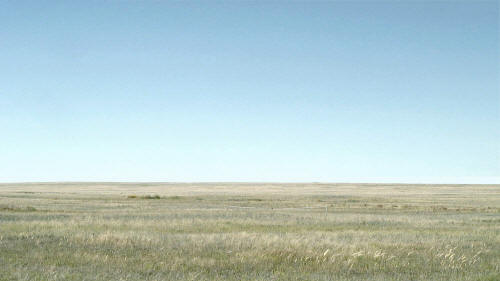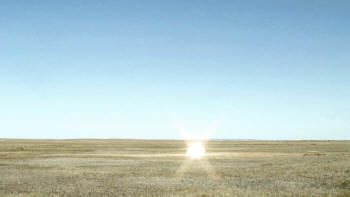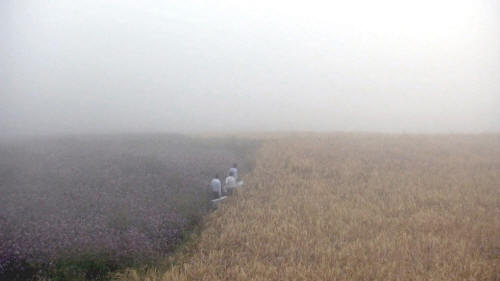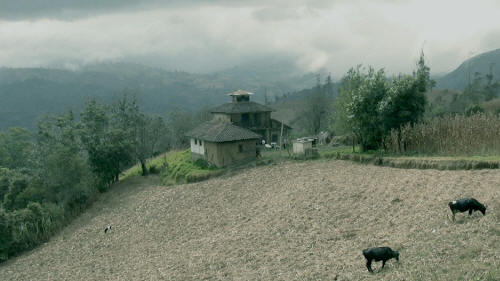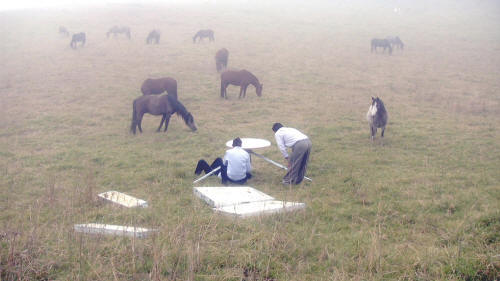|
|
| home | features | exhibitions | interviews | profiles | webprojects | gazetteer | links | archive | forum |
|
Two writer's responses to Live Art Falmouth 2008 pt2:
Myth as context: the films of Jon FawcettAlexandra Glanville
'The Sublime emerges when there is no longer a beautiful form.' (Lyotard, 1989) 'Transformer (Kazakhstan)' is an exercise in observation, focus, anticipation. It demands a state of alertness to appearances, to know what is important. It defines the scale of differences: what is scrutinised when the field of vision is static – barely discernible breeze, lack of cast shadow, unmappable and unremarkable variations in contour – contrasted with what is grasped at with every change of shot – an immediate and vulnerable attempt to ascertain the scale of the landscape, the nature of threat where 'animal' is absent, vain measure of time (interval, duration).
A controlled explosion. A plume of pale smoke fixes our gaze, the formless mass lifts away from its source, begins to disperse, travels towards us, continues to drift beyond our position. Beneath it, the smooth movement of its shadow crosses the ground, dark, untextured, seeming to have more substance than that which it follows: seductive, distracting, treacherous. Where or what is the fixed point? Is this narrative or situation? What follows? As audience, we seem to occupy an unknowable position, both subjectively and politically. 'Wheel (Ecuador)' elaborates on this relationship between the viewing subject and the object of sublime apprehension, recalling Ingmar Bergman's definition of 'the theatrical space [as being] that charged emptiness from which all magic would occur.'
A mythologised rite that could precede or precipitate some other action or rite, redolent of folk-tellings of liminal journeys, some unspecified rite of passage. There is an element undisclosed – a deity perhaps, or hero, or unwary traveller who as subject might complete the narrative. Wild ponies contemplate the quiet actions of three men in their shirt-sleeves conveying bundled elements of some structure - which becomes a circular base on a tripod – this time through intimately variable topography. Locations shift, the track towards a farmhouse, a clearing in a forest, a cornfield, open grassland – these are archetypal settings, each with a myriad associations for what might follow.
The element of neutrality, unpredictability and the staging of myth that transgresses the notion of three-dimensional space and linear time, (as Lyotard(1973) perceives the disturbance created by a physically apprehensible 'sublime') is here amplified through sequential though unresolved actions.
Ewelina Kolaczek and Nelly Alfandari: ‘Am I Good?’Mark Greenwood
The manifestations of a compulsion to repeat that we have described with respect to the early activities of the infant psyche and also with respect to our experiences in the course of psychoanalytic practice, plainly bear the stamp of drives, and wherever they are in opposition to the pleasure principle they equally plainly exhibit their daemonic character. Freud: Beyond the Pleasure Principle
An encounter with Kolaczek and Alfandari. Basques rigid and taut, spines framed and tied tight, splitting bare flesh. Bodies trussed and prepared. Naked legs and unpinned brown hair. A set of twins. One sits, one stands and stares accusingly. The fear of twins (concerophobia, also fear of simultaneity) provoked primitive cultures to kill one or both twins at birth, believing the second was a physical manifestation of the soul. An ancient geminicide lies repressed and deep, primeval reminders from a history of misunderstanding. History has a tendency of repeating itself, and so too the present and the future. The twins in this white space secure our gaze and the emotions I feel; joy, sorrow, relief - and at the moment of repression, I reconstitute these emotions as morbid anxiety. ‘Am I good?’ whispers Kolaczek. She demands an answer. She needs to know the measures of her success. The repetitive enquiry determines and fixes experience of her presence. Radical instabilities begin to reveal themselves in a question that seeks to quantify perceptions of identity, being and representation. I am witness to a process of restriction inscribed in the mind and on the body. Purification and the violent integrating of past traumas into a psychic economy. I testify to an act of realization: I am the by-stander fixed within a process of self-affirmation where the acts of remembering, repeating and re-working become ritualized. Am I? I am. Other attendant witnesses are led by the hand to Kolaczek. Alfadari gestures them to tug at the cords of the bodice. They carry out the task. Flesh is squeezed together; blood is brought to the surface of the skin as air escapes through the mouth. The question is repeated, no longer whispered but building in intensity, towards anger and exhaustion. More witnesses are implicated. Our actions become complicit and compulsory until the corset begins to suffocate. The breath quickens. The pulse explodes. The skin begins to break. The action becomes insufferable… Thus we repeat out of libidinal desire, and repeat out of a desire for punishment; the Over-I and the It assert themselves at the expense of the bewildered self. Alfandari helps Kolaczek to her feet. The corset is slackened. The flesh is free. The pair embrace. The pain is over and the ritual complete. A jouissance. Relief and release. They breathe together. A catharsis complete. Their clasp is absolute. The air surrounding their bodies is palpable. Is she good? I hope so.
|
|
|

